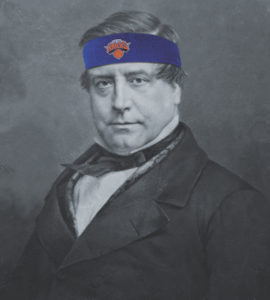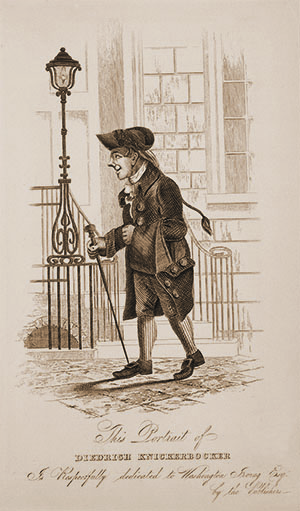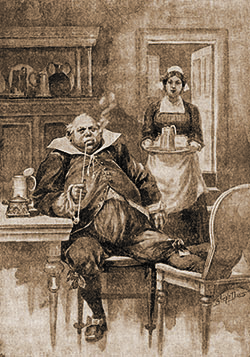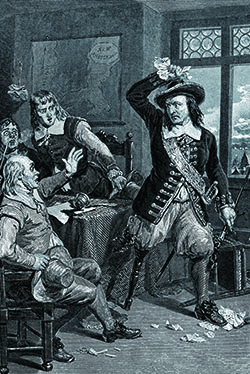Washington Irving’s fictional Dutch uncle lent his name to all things New York
In 1946, when New York City obtained a professional basketball team, the promoters wanted the franchise to have a quintessentially New York City name. The unanimous choice was “Knickerbockers,” a term associated with the city’s origins as a Dutch colony but which had come to signify “New York.” Today, the Knicks may be the most famous users of the old Dutch name, but long before basketball, there was the Knickerbocker Club, the Knickerbocker Hotel, the steamboat Knickerbocker, the Knickerbocker literary magazine, and countless products, including a popular beer, all capitalizing on a moniker that implied a Gotham pedigree.

“Knickerbocker” as a sobriquet started with Manhattan native Washington Irving—specifically, with one of Irving’s alter egos: “the historian Diedrich Knickerbocker,” fictional author of the writer’s debut book, A History of New York: From the Beginning of the World to the End of the Dutch Dynasty. First published in 1809, Irving’s parody sold well on both sides of the Atlantic, thanks largely to the imaginary Diedrich’s hilarious treatment of the Dutch colony of New Netherland and its lackadaisical denizens: the Van Winkles and the Van Warts, the Van Nests, and the Van Bummels—actual personages rendered in exaggerated comic relief.
The book’s popularity quickly made “Knickerbocker” synonymous with Roosevelts, Schuylers, Beekmans, and other specimens of New York’s Dutch-descended elite. In time, use of the label expanded to all native New Yorkers, meanwhile serving Manhattan high society as a substitute for “patroon,” the Dutch legal title given powerful colonial landowners (see “Portraying and Parodying Patroons,” below).
Diedrich may have been imaginary but his “relatives,” whose surname’s spelling evolved, were real. The first to settle in the Dutch/English colony was Harman Janse Wyekycbacke, a fur trader whose descendants prospered as upstate landowners. In A History of New York, Irving would use the family’s rural mansion as Diedrich’s ancestral home.
boyhood, Irving had delighted in Dutch culture, then still flourishing in towns and villages along the Hudson River. During the writer’s youth, Dutchness had all but vanished from New York City. Further north, people still spoke the language and distinctively Dutch stepped-gable houses still lined the thoroughfares of Albany, the state capital.
In 1808, Irving was a floundering New York City lawyer who published satirical columns in local newspapers. He and brother Peter started writing a full-length lampoon of New York City history but the project was interrupted by two deaths within a year: their sister Ann in spring 1808, and Washington’s fiancée, Matilda Hoffman. The brothers put aside the project and a bereft Washington retreated to a lawyer friend’s house in the village of Kinderhook, 127 miles upstate.
As a distraction from his grief, Irving resumed writing A History of New York on his own, refocusing the narrative from British-run Manhattan to the little-known days when New York State was part of New Netherland, a Dutch colony.

Following his sister’s death, Irving had visited the Knickerbacker family estate in Schaghticoke, north of Albany. According to the Knickerbocker Historical Society, the writer was a guest of Johannes Knickerbacker III, the mansion’s builder and a Revolutionary War veteran. At the residence, Irving would have seen a portrait of his host wearing knee breeches and broad-brimmed hat, and many other portraits and heirlooms of the Knickerbacker family’s long history. Irving appropriated the family name—changing it slightly for comic effect—and made “Diedrich Knickerbocker” his seriocomic novel’s narrator, as well as a fictional relative of the Knickerbacker family.
In “An Account of the Author,” the introduction to A History of New York, Irving described Diedrich as “a small brisk looking old gentleman, dressed in a rusty black coat, a pair of olive velvet breeches, and a small cocked hat,” his only finery square silver shoe buckles. Irving, 26, had great fun making Diedrich a source of uproarious exaggeration.
To launch the book, the young author planned a hoax: Diedrich’s mysterious disappearance from a hotel on Mulberry Street in Manhattan, as reported by a fictional landlord in paid notices Irving placed in the Evening Post.
“About two months ago, he went out of a morning, with a bundle in his hand—and has never been heard of since,” the “landlord” explained in one advertisement. The landlord had learned that Diedrich was “of very great connexions, being related to the Knickerbockers of Scaghtikoke,” but said these relations hadn’t seen the old fellow either. Supposedly abandoned in Diedrich’s lodgings was the manuscript for A History of New York, and the “landlord” posted that he would be publishing that work to cover his missing tenant’s unpaid rent.
For security’s sake, Irving had a publishing house in Philadelphia print the book. In America’s first literary publicity stunt, poor Diedrich’s plight enthralled the public, and the book made Irving a celebrity, admired by Sir Walter Scott, Lord Byron, and other notables.

In a typically droll passage on the “colony of huge feeders,” Diedrich writes: “The Dutch possessions in this part of the globe began now to assume a very thriving appearance, and were comprehended under the general title of Nieuw Nederlandts, on account, no doubt, of their great resemblance to the Dutch Netherlands—excepting that the former were rugged and mountainous, and the latter level and marshy.” A History of New York concerns three of the colony’s actual directors: Wouter “the Doubter” Van Twiller, whose oblong body, “particularly capacious at bottom,” Diedrich compares to a beer barrel with an onion for a head. He praises Wouter for dozing through his administration, allowing the colony to flourish; William “the Testy” Kieft (remembered in real life for waging a disastrous war against the mostly friendly Lenape tribes), who “enriched the province by a multitude of good-for-nothing laws” while the people became “exceedingly enlightened and unhappy” under his rule; Peter “the Headstrong” Stuyvesant, whose exploits Diedrich summarizes as “the rise and renown of a valiant commander, showing that a man, like a bladder, may be puffed up to
greatness and importance, by mere wind.”
Irving’s buffoonish colonists care far more about eating, drinking, and napping than they do governance, yet through one rollick after another, they ensure the colony’s survival. Panicked by the sight of an English ship, New Amsterdam’s fictional residents “fell to smoking their pipes with astonishing vehemence; in so much that they raised a cloud” concealing the town. The terrible English captain passes, “totally unsuspicious of the sturdy Dutch settlement snugly couched under cover” of tobacco smoke.
Many Dutch families took offense at A History of New York and at Irving’s caricatures of their forebears. Certainly the esteemed Van Cortlandt family had reason to rage: Irving portrayed Oloff van Cortlandt, a common soldier who rose to become one of the colony’s most powerful men, as Olaffe Van Kortlandt, an unwashed peasant who faked his noble background.
In time, Irving’s personal charm, acclaim for the book, and the interest it generated in Dutch colonial culture won over many New Netherland descendants. Visiting Albany in 1810, the author was lionized, though many capital residents—undoubtedly including Van Rensselaers, Schuylers, and Ten Broecks—were “very slow to extend any civility.” Irving wrote to a friend about how he had “intrenched myself strongly in the parlors of several genuine Dutch families who had declared utter hostility to me. Several good old ladies, who had almost condemned my book to the flames, have taken me into high favor.”

In 1811, while on family business in Washington, DC, Irving encountered Johannes III’s son, Congressman Herman Knickerbocker, mentioned in A History as Diedrich’s “cousin.” Himself a wit, Herman enjoyed the book and became a lifelong friend of Irving. Irving’s next book, The Sketch Book of Geoffrey Crayon, Gent., published serially in 1819-20, was an international bestseller. Diedrich is credited as the “posthumous” author of its Dutch Hudson Valley stories, “The Legend of Sleepy Hollow” and “Rip Van Winkle”—historical fantasies that would make Irving America’s first man of letters.
By then, “Knickerbocker” was enlivening New York City’s vernacular. In 1833, a new literary monthly was calling itself The Knickerbocker, New-York Monthly Magazine. Irving wrote the preface for the premier issue in the guise of a conversation with the long-dead Diedrich, who appears as a phantasm. The Knickerbocker lasted more than 30 years. Contributors, including James Fenimore Cooper and Henry Wadsworth Longfellow, became known as the Knickerbocker Group.
Commercial appropriation of “Knickerbocker” proliferated. In an author’s essay for his final edition of A History in 1848, Irving commented, “When I find its very name become a ‘household word’ and used to give the home stamp to everything recommended for popular acceptance such as Knickerbocker societies, Knickerbocker insurance companies, Knickerbocker steamboats, Knickerbocker omnibuses, Knickerbocker bread, and Knickerbocker ice; and when I find New Yorkers of Dutch descent priding themselves on being ‘genuine Knickerbockers’—I please myself with the persuasion that I have struck the right chord.”
The “right chord” continued to ring long after Irving’s death in 1859. By the 1870s, New York’s Dutch-descended patrician class was known as the Knickerbocracy. Members varied widely in outlook. Some displayed a sense of civic duty and disdain for ostentation. One young Knickerbocrat was elected to the state assembly solely on his Old Dutch lineage, and he became even more famous than Irving: Theodore Roosevelt, a descendant, six times removed, of New Amsterdam’s Claes Rosenvelt.
Knickerbocker cachet grew with every generation. The Schermerhorns, a shipping family, may have birthed the ultimate in Knickerbockerness. Caroline Schermerhorn, born in 1830, married a grandson of fur trader John Jacob Astor, the richest man in America. Wealth and ancestry gave Mrs. Astor absolute power to decide who in Gilded Age New York was fashionable. With her Fifth Avenue mansion and Newport cottage, she wielded an iron hand to create the Four Hundred, her roster of upper-crust clans, and preside as the city’s doyenne.
Even in the 20th century, the Knickerbocracy was the highest of high society. The Hearst papers’ “Cholly Knickerbocker” column reported on their parties and outings—and slyly referred to their peccadillos— from 1891 to 1963. “Chollies” included newspaperman Maury Paul and socialite Igor Cassini (with ghostwriting assistance from Liz Smith). The last Cholly was Charles A. Van Rensselaer, a Knickerbocker himself. Cholly was succeeded by “Suzy Knickerbocker” Aileen Mehle, whose column appeared in the New York Post into the 1980s.
If only Diedrich had been a Cholly. ✯
Portraying and parodying patroons

Struggling to extend its mercantile empire into North America in the early 1600s, the Netherlands claimed the territory between the North and the South rivers—today the Hudson and the Delaware—and the area’s rich trade in timber, fur, and land. To protect against English and French encroachment, the Dutch West India Company’s directors devised the patroon system—the word comes from the Latin pater, meaning father—in which the company gave investors huge tracts with jurisdiction similar to that of feudal lords.
Dutch West India Company patroons received a 10-year exemption from most taxes and some were allowed individual trade with natives, paying the company an export duty of one guilder on every beaver or otter skin. A patroon had to bring in 50 or more adult settlers, demanding that he have sufficient capital to carry the expense of outfitting and protecting a settlement. This proposition attracted few takers.
In 1640, to attract small farmers, the West India Company started offering free land and advantageous shipping rates.
Successful patroons led the colony. Killaen Van Rensselaer, an Amsterdam diamond merchant and one of the Dutch West India Company’s founding directors, was the most prominent. Van Rensselaer’s New Netherland fiefdom started in the vicinity of the Dutch West India Company’s trading post at Fort Orange, in today’s Albany, and he recruited farmers, artisans, tradesmen, and laborers from across Europe. With land he bought from Indians, Killaen expanded his patroonship of “Rensselaerswyck” to almost a million acres, stretching north and south of Fort Orange on both sides of the North River.
One reason Van Rensselaer succeeded was geography: his settlement extended to the confluence of the North and Mohawk rivers, providing access to the western Indian trade. Rensselaerswyck remained in that family’s hands into the mid-1800s, a measure of success unmatched by any other patroon and his descendants—not even Oloff Van Cortlandt of the Bronx, father of two early New York City mayors, Stephanus and his brother Jacobus.
In Irving’s A History of New York, Diedrich Knickerbocker describes Killaen as “a lofty, lordly kind of man, furnished with huge mustaches and clad in Flemish doublet and hose, and an insufferably tall hat, with a cocktail feather,” who looked down upon “the portly, short-legged burgomasters” of New Amsterdam. The real Killaen never actually set foot in New Netherland, conducting business from Holland through agents until his sons could take over.
Van Rensselaer’s agents, however, failed to obtain Beverwyck, the haphazard settlement that sprang up around Fort Orange. Peter Stuyvesant, a military commander and director-general of the Dutch West India Company, kept Beverwyck under company control, thwarting Van Rensselaer.
Stuyvesant was undone by his dictatorial personality, alienating the colonists by issuing edicts against “unreasonable and intemperate drinking,” especially on the Sabbath. When English warships sailed into New Amsterdam harbor in 1664, Stuyvesant’s countrymen refused his call to arms, allowing the interlopers to seize New Netherland without firing a shot. The English christened the harbor town New York.
The Knickerbackers, whose name Irving appropriated and respelled, were relative latecomers to New Netherland, but they established a land-holding dynasty.
Patriarch Harman Janse Wyekycbacke emigrated from Friesland, Holland, in 1673, during the single year in which the Netherlands controlled the colony during the Third Anglo-Dutch war of 1672-1674. To end the hostilities, the Dutch ceded New Netherland to the English the next year.
Harman, who listed his occupation as rope maker, was part of a surge of Dutch émigrés who left behind comfortable lives for the greater opportunities in the colony. He worked in the fur trade and amassed properties patroon-style.
Harman married Lysbeth van Bogaert, daughter of the quartermaster of Fort Orange, and bought land south of the fort and east across the river in Kinderhook. He paid 300 guilders’ worth of “good whole merchantable beaver skins,” with an Albany property listed as collateral.
Rent to the landowner for a typical Kinderhook farmstead was 18 bushels of wheat, four fowls, and a day’s service per year. Development in Albany spread north along the riverbank, “attracting those who were eager to engage in the lucrative fur trade with native tribes to the north and west and those who were reluctant to submit to the authority” of the Van Rensselaer family. Harman was one of those pioneers.
In 1682, records show, “Harman Kinnekerbacker” purchased an immense parcel of land 20 miles north of Albany, “over against the skachkook [Schaghticoke] path for 30 good saleable beaver skins.” Kinnekerbacker soon relocated south to a substantial property across the river from the fort settlement of Kingston. He left a stake in his wilderness holdings, in a river valley the Indians called Schaghticoke, to his oldest son, Johannes Knickerbacker. Johannes bought more property from the Indians, and his son, Johannes II, presided over an estate of more than a thousand acres.
In the 1770s, Johannes III built a mansion on his grandfather’s old homestead, using construction methods from medieval-era Holland. The front door was split in two horizontal sections swinging on heavy iron hinges, to let air in and keep livestock out. This “Dutch door” also had a large brass knocker, a detail of Dutch culture later made famous by Irving.
Congressman Herman Knickerbocker, Johannes III’s son, grew up in the Schaghticoke mansion before moving to Albany to practice law. He didn’t meet Irving until after publication of A History. The two men became fast friends and Herman changed the spelling of his surname to match that of his fictional cousin. Many of Herman’s numerous sons and nephews kept the famous spelling. Several members of the extended family lived in New York City, including socialite Henry Knickerbocker, and were part of the Gilded Age’s Knickerbocracy. —Ann Morrow

